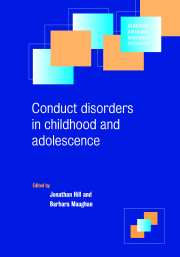Book contents
- Frontmatter
- Contents
- List of contributors
- Preface
- 1 Bad behaviour: an historical perspective on disorders of conduct
- 2 Can the study of ‘normal’ behaviour contribute to an understanding of conduct disorder?
- 3 The development of children's conflict and prosocial behaviour: lessons from research on social understanding and gender
- 4 Neural mechanisms underlying aggressive behaviour
- 5 Biosocial influences on antisocial behaviours in childhood and adolescence
- 6 The epidemiology of disorders of conduct: nosological issues and comorbidity
- 7 Conduct disorder in context
- 8 Genetic influences on conduct disorder
- 9 The role of neuropsychological deficits in conduct disorders
- 10 A reinforcement model of conduct problems in children and adolescents: advances in theory and intervention
- 11 Perceptual and attributional processes in aggression and conduct problems
- 12 Attachment and conduct disorder
- 13 Friends, friendships and conduct disorders
- 14 Continuities and discontinuities of development, with particular emphasis on emotional and cognitive components of disruptive behaviour
- 15 Treatment of conduct disorders
- 16 The prevention of conduct disorder: a review of successful and unsuccessful experiments
- 17 Economic evaluation and conduct disorders
- 18 Antisocial children grown up
- 19 Conduct disorder: future directions. An afterword
- Index
4 - Neural mechanisms underlying aggressive behaviour
Published online by Cambridge University Press: 11 August 2009
- Frontmatter
- Contents
- List of contributors
- Preface
- 1 Bad behaviour: an historical perspective on disorders of conduct
- 2 Can the study of ‘normal’ behaviour contribute to an understanding of conduct disorder?
- 3 The development of children's conflict and prosocial behaviour: lessons from research on social understanding and gender
- 4 Neural mechanisms underlying aggressive behaviour
- 5 Biosocial influences on antisocial behaviours in childhood and adolescence
- 6 The epidemiology of disorders of conduct: nosological issues and comorbidity
- 7 Conduct disorder in context
- 8 Genetic influences on conduct disorder
- 9 The role of neuropsychological deficits in conduct disorders
- 10 A reinforcement model of conduct problems in children and adolescents: advances in theory and intervention
- 11 Perceptual and attributional processes in aggression and conduct problems
- 12 Attachment and conduct disorder
- 13 Friends, friendships and conduct disorders
- 14 Continuities and discontinuities of development, with particular emphasis on emotional and cognitive components of disruptive behaviour
- 15 Treatment of conduct disorders
- 16 The prevention of conduct disorder: a review of successful and unsuccessful experiments
- 17 Economic evaluation and conduct disorders
- 18 Antisocial children grown up
- 19 Conduct disorder: future directions. An afterword
- Index
Summary
Introduction
Inappropriate aggression and violence is a pervasive feature of contemporary society. In humans, it affects all ages; violent behaviour in children (e.g. conduct disorder) is relatively common. Understanding, prevention and treatment of these conditions is frequently incomplete and unsatisfactory. At a research level, there is often little integration between sociological, psychological and neurobiological approaches, even though the three address the same topic. An additional problem with aggression is that it is a compendium of different behaviours.
The great advances in our knowledge of brain function have helped our understanding of the neural mechanisms underlying behaviour. This chapter focuses on what we know of these as they apply to aggression. It draws evidence both from studies on experimental animals, and investigations of normal humans or those with a variety of illnesses. Experimental and clinical studies give very different information, but must be integrated if rational therapy for unwanted or excessive aggression is to be developed.
First, we define aggression and its relation to other social behaviours. Next, we discuss the structure of the brain as it relates to aggression, with particular emphasis on the limbic system. This anatomical view of the brain is complemented by its neurochemical architecture, and we discuss this in relation to aggressive behaviour.
Keywords
- Type
- Chapter
- Information
- Conduct Disorders in Childhood and Adolescence , pp. 67 - 102Publisher: Cambridge University PressPrint publication year: 2000
- 1
- Cited by

